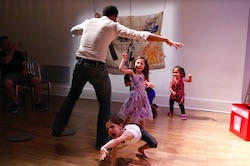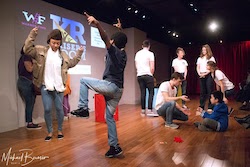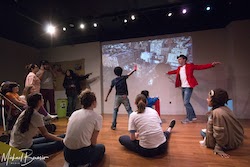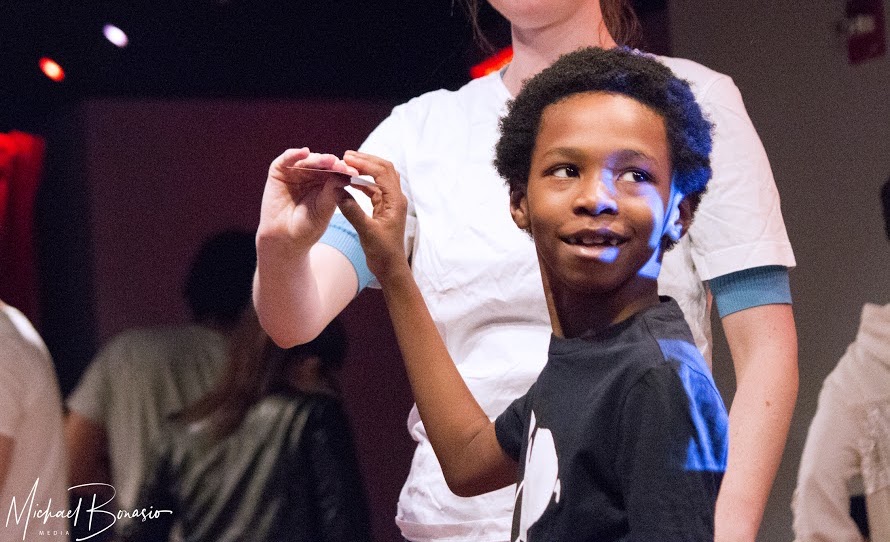“The boy I was working with was hiding under his chair,” remembers Stephane Duret during a performance with the Red Kite Project. “So, I crawled under my chair, too. Then, he looked at me right in the eyes. We had made a connection — I had the green light.”

Kaiser’s Room. Photo by Michael Bonasio.
Duret’s experience working at Chicago Children’s Theatre’s Red Kite Project and then the Son-Rise program with a five-year-old autistic boy named Kaiser changed his life forever. Duret earned his BFA in musical theater and was already working professionally, but seeing how the arts could foster a deeper human connection gave him a new perspective and appreciation for its transformative power and purpose. In 2015, Duret founded his own non-profit organization that would utilize the arts to promote imagination, inclusivity, connection and a culture of “yes.” He named the organization Kaiser’s Room.
Kaiser’s Room is a New York City-based 501©3 not-for-profit that provides performing arts programming to individuals of all abilities. It offers an immersive performing arts experience — both classes and performances — for people of all ages with cognitive and developmental disabilities. “We create an inclusive, welcoming environment for people of all abilities to explore their creativity through the arts,” explains Duret. “Our programs support a wide range of therapeutic and educational goals, while keeping the atmosphere fun and engaging.”
Classes are up to 45 minutes long and usually focus on a theme or game while incorporating a lot of improvisation and creativity. “It’s a safe space for any and all experiences,” explains Philip Dallmann, executive director of Kaiser’s Room. “We believe that for any person, regardless of ability or diagnosis, connection is the key to authentic growth and happiness. We’re not looking to correct behaviors or necessarily increase certain social skills, but we provide a safe and inviting ecosystem that allows for the possibility of connection.”
Classes are capped at just seven students, with between two and three teaching artists leading the room. This intimate setting allows for more individualized attention, where the teachers and students really get to know one another week after week.

Kaiser’s Room. Photo by Michael Bonasio.
The arts offer a unique opportunity to integrate essential skills like communication, movement, language development and ensemble building into fun and engaging activities. Simple “arts” games can be really impactful. Crossing your hands to tap opposite knees across the body line actually fires important brain synapses. Clapping in rhythm, breathing deeply and isolating different body parts can be very grounding, especially when one’s body is on sensory overload.
Other, non-physical, elements of the performing arts apply to the mission of Kaiser’s Room. There’s a freedom in the arts — tapping into another character that isn’t yourself, knowing that there is no right or wrong, and having the power to change the direction in which you’re going. Duret adds, “We want to cultivate a world of yes through imagination, adaptability and letting each individual express his or her true personality.”
He continues, “We not only serve our students but also our teaching artists.” Both parties need each other in a symbiotic relationship. “The students respond to the empathy, passion and energy of our teachers, and our teachers get the opportunity to explore, create, and think on their feet, to really use their performing arts backgrounds.”
“We empower our teaching artists to bring their talents and strengths to the table,” notes Dallmann. “We have actors, modern dancers and musicians who all work as a collective team.”
What’s more, the teaching artists are paid very well, so Kaiser’s Room is a wonderful and meaningful part-time job for a working artist. “It’s important for us to stay in dialogue with the community,” Dallmann adds, “by asking both the parents of our students what they need and also understanding how we can best support and challenge our teaching artists.”

Kaiser’s Room. Photo by Michael Bonasio.
Once a person on the spectrum reaches age 21, they “age out” of government funding for education, classes, therapy and other activities. Perhaps resultantly, there is an 80 percent unemployment rate for adults with cognitive and developmental disabilities. “At Kaiser’s Room, our doors are open to anyone — ages three to 83!” explains Dallmann. “We don’t turn anyone away based on disability, age or any other reason.” Still, Kaiser’s Room focuses on keeping classes intimate and individualized. Another goal is to have greater representation of people with cognitive and developmental disabilities on their board of directors and staff of teaching artists.
Kaiser’s mom, Denise, explains how the arts have impacted her son’s life. “I truly believe that [Kaiser’s] confidence in expressing himself creatively and his ability to engage with others are very much the result of having had a safe space to do so with the support of so many individuals (many of them artists) who understood that he needed to be emotionally invested to learn and grow.”
And although still a young organization, Kaiser’s Room has big plans. “Our goals,” says Dallmann, “are to be present in all five boroughs and to offer completely free programming by 2021.”
To learn more about Kaiser’s Room, donate to the organization, sign up for a class or inquire about a position as a teaching artist, visit www.kaisersroom.org.
By Mary Callahan of Dance Informa.









